check engine RENAULT SCENIC 2011 J95 / 3.G Engine And Peripherals EDC16 Workshop Manual
[x] Cancel search | Manufacturer: RENAULT, Model Year: 2011, Model line: SCENIC, Model: RENAULT SCENIC 2011 J95 / 3.GPages: 365, PDF Size: 2.11 MB
Page 325 of 365
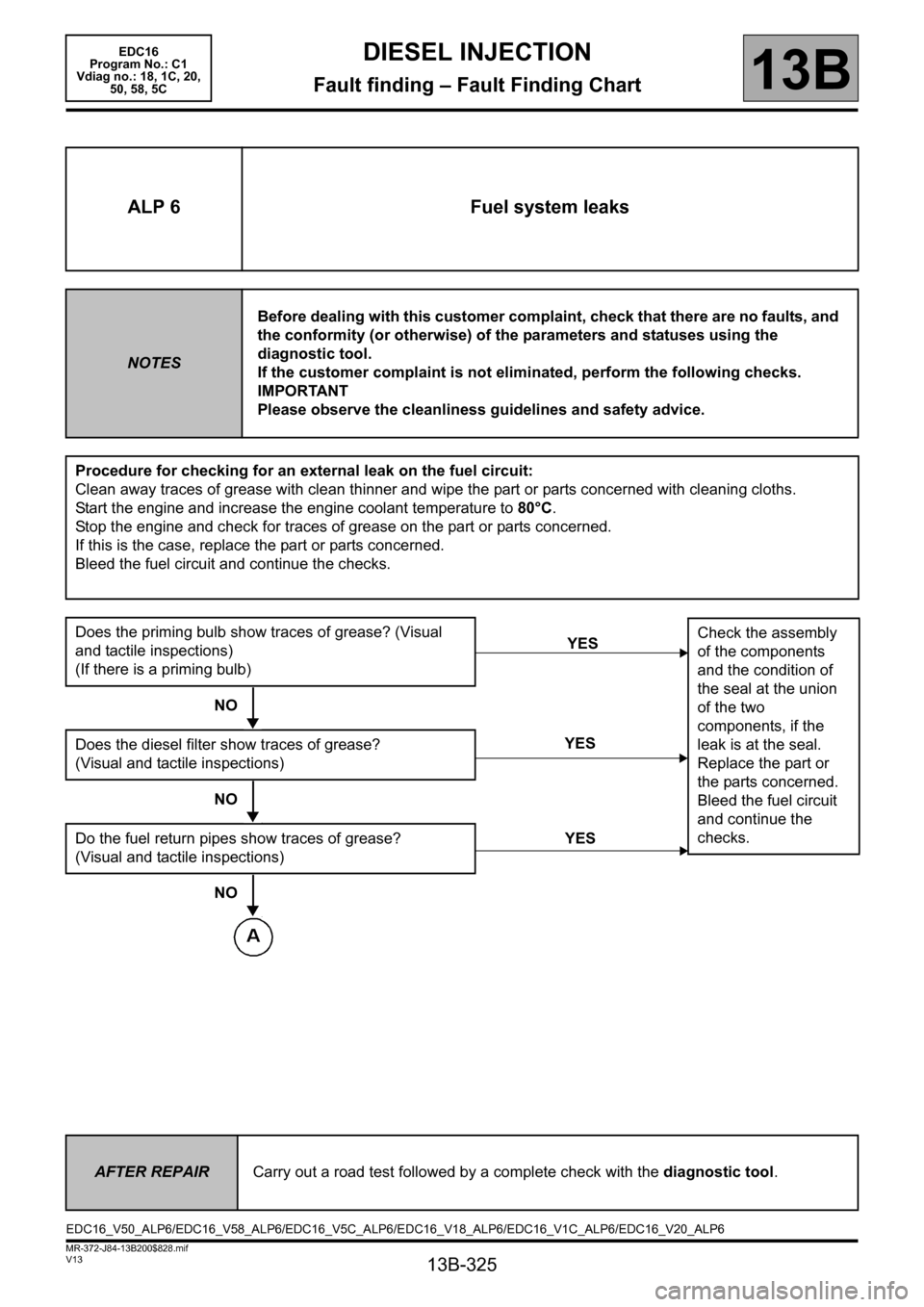
13B-325
MR-372-J84-13B200$828.mif
V13
EDC16
Program No.: C1
Vdiag no.: 18, 1C, 20,
50, 58, 5CDIESEL INJECTION
Fault finding – Fault Finding Chart13B
ALP 6 Fuel system leaks
NOTESBefore dealing with this customer complaint, check that there are no faults, and
the conformity (or otherwise) of the parameters and statuses using the
diagnostic tool.
If the customer complaint is not eliminated, perform the following checks.
IMPORTANT
Please observe the cleanliness guidelines and safety advice.
Procedure for checking for an external leak on the fuel circuit:
Clean away traces of grease with clean thinner and wipe the part or parts concerned with cleaning cloths.
Start the engine and increase the engine coolant temperature to 80°C.
Stop the engine and check for traces of grease on the part or parts concerned.
If this is the case, replace the part or parts concerned.
Bleed the fuel circuit and continue the checks.
Does the priming bulb show traces of grease? (Visual
and tactile inspections)
(If there is a priming bulb)
NO
Does the diesel filter show traces of grease?
(Visual and tactile inspections)
NO
Do the fuel return pipes show traces of grease?
(Visual and tactile inspections)
NO
YESCheck the assembly
of the components
and the condition of
the seal at the union
of the two
components, if the
leak is at the seal.
Replace the part or
the parts concerned.
Bleed the fuel circuit
and continue the
checks.
YES
YES
AFTER REPAIRCarry out a road test followed by a complete check with the diagnostic tool.
EDC16_V50_ALP6/EDC16_V58_ALP6/EDC16_V5C_ALP6/EDC16_V18_ALP6/EDC16_V1C_ALP6/EDC16_V20_ALP6
Page 327 of 365
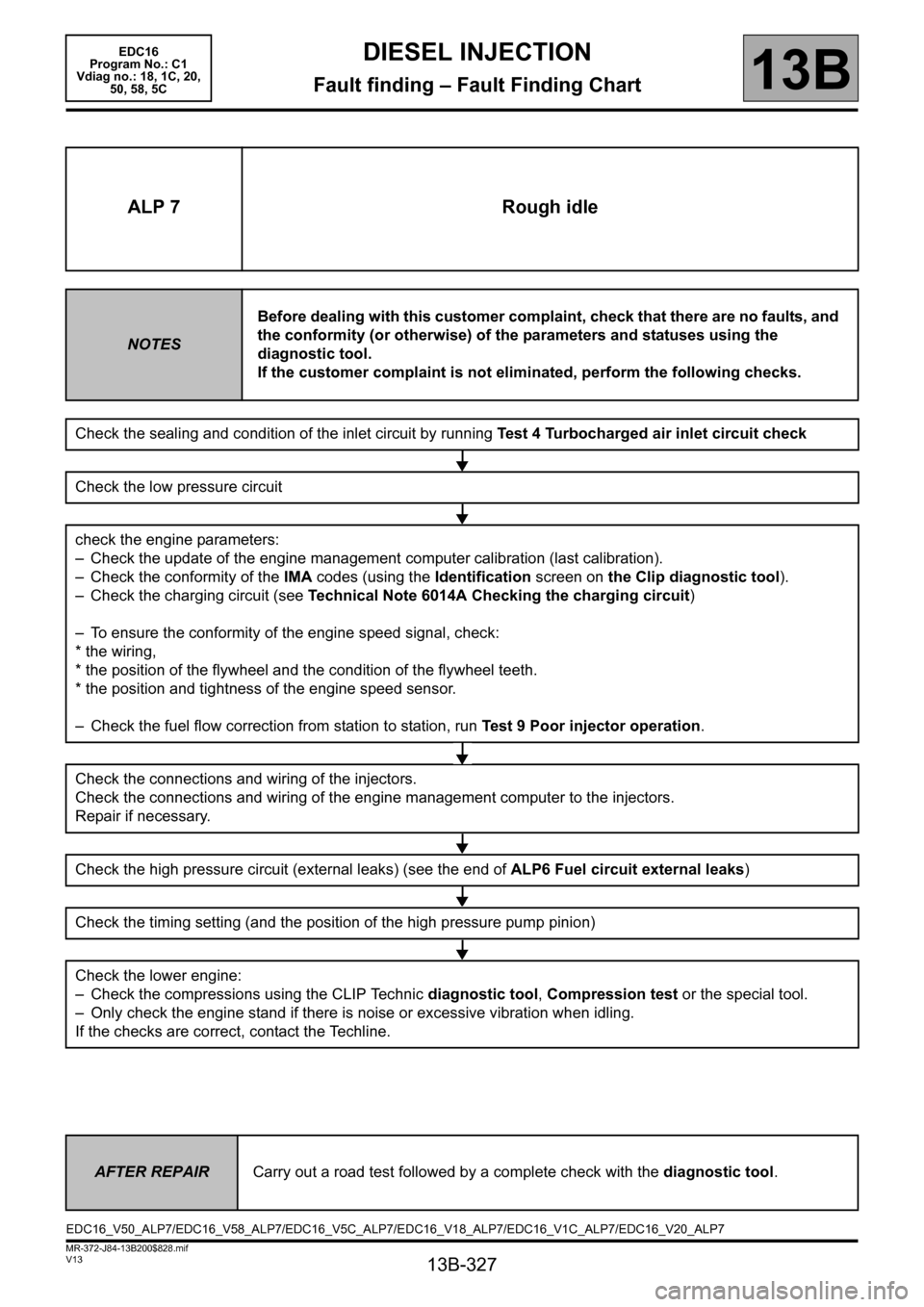
13B-327
MR-372-J84-13B200$828.mif
V13
DIESEL INJECTION
Fault finding – Fault Finding Chart
EDC16
Program No.: C1
Vdiag no.: 18, 1C, 20,
50, 58, 5C
13B
ALP 7 Rough idle
NOTESBefore dealing with this customer complaint, check that there are no faults, and
the conformity (or otherwise) of the parameters and statuses using the
diagnostic tool.
If the customer complaint is not eliminated, perform the following checks.
Check the sealing and condition of the inlet circuit by running Test 4 Turbocharged air inlet circuit check
Check the low pressure circuit
check the engine parameters:
– Check the update of the engine management computer calibration (last calibration).
– Check the conformity of the IMA codes (using the Identification screen on the Clip diagnostic tool).
– Check the charging circuit (see Technical Note 6014A Checking the charging circuit)
– To ensure the conformity of the engine speed signal, check:
* the wiring,
* the position of the flywheel and the condition of the flywheel teeth.
* the position and tightness of the engine speed sensor.
– Check the fuel flow correction from station to station, run Test 9 Poor injector operation.
Check the connections and wiring of the injectors.
Check the connections and wiring of the engine management computer to the injectors.
Repair if necessary.
Check the high pressure circuit (external leaks) (see the end of ALP6 Fuel circuit external leaks)
Check the timing setting (and the position of the high pressure pump pinion)
Check the lower engine:
– Check the compressions using the CLIP Technic diagnostic tool, Compression test or the special tool.
– Only check the engine stand if there is noise or excessive vibration when idling.
If the checks are correct, contact the Techline.
AFTER REPAIRCarry out a road test followed by a complete check with the diagnostic tool.
EDC16_V50_ALP7/EDC16_V58_ALP7/EDC16_V5C_ALP7/EDC16_V18_ALP7/EDC16_V1C_ALP7/EDC16_V20_ALP7
Page 328 of 365
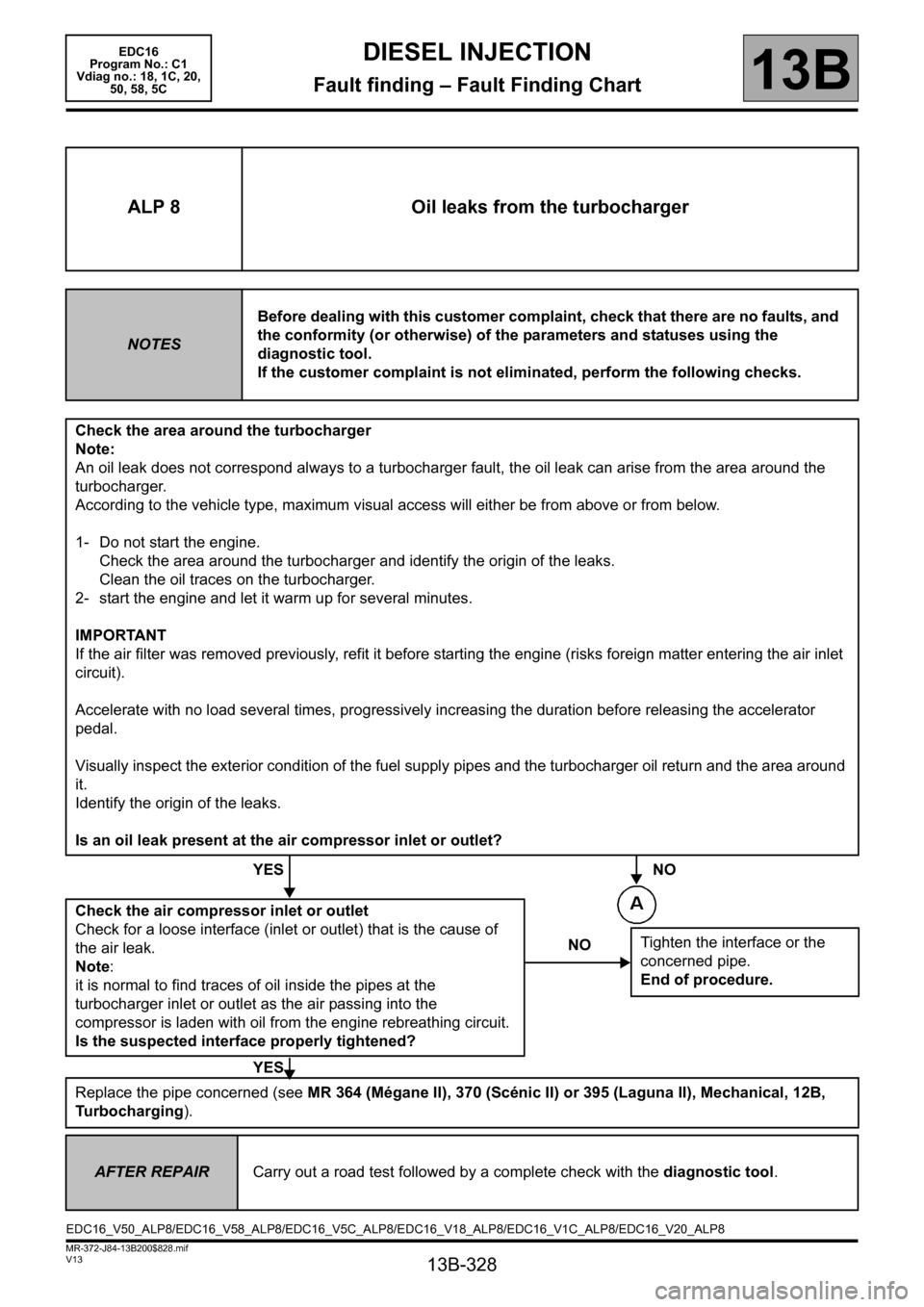
13B-328
MR-372-J84-13B200$828.mif
V13
EDC16
Program No.: C1
Vdiag no.: 18, 1C, 20,
50, 58, 5CDIESEL INJECTION
Fault finding – Fault Finding Chart13B
ALP 8 Oil leaks from the turbocharger
NOTESBefore dealing with this customer complaint, check that there are no faults, and
the conformity (or otherwise) of the parameters and statuses using the
diagnostic tool.
If the customer complaint is not eliminated, perform the following checks.
Check the area around the turbocharger
Note:
An oil leak does not correspond always to a turbocharger fault, the oil leak can arise from the area around the
turbocharger.
According to the vehicle type, maximum visual access will either be from above or from below.
1- Do not start the engine.
Check the area around the turbocharger and identify the origin of the leaks.
Clean the oil traces on the turbocharger.
2- start the engine and let it warm up for several minutes.
IMPORTANT
If the air filter was removed previously, refit it before starting the engine (risks foreign matter entering the air inlet
circuit).
Accelerate with no load several times, progressively increasing the duration before releasing the accelerator
pedal.
Visually inspect the exterior condition of the fuel supply pipes and the turbocharger oil return and the area around
it.
Identify the origin of the leaks.
Is an oil leak present at the air compressor inlet or outlet?
YES NO
Check the air compressor inlet or outlet
Check for a loose interface (inlet or outlet) that is the cause of
the air leak.
Note:
it is normal to find traces of oil inside the pipes at the
turbocharger inlet or outlet as the air passing into the
compressor is laden with oil from the engine rebreathing circuit.
Is the suspected interface properly tightened?
YES
Replace the pipe concerned (see MR 364 (Mégane II), 370 (Scénic II) or 395 (Laguna II), Mechanical, 12B,
Turbocharging).
NOTighten the interface or the
concerned pipe.
End of procedure.
AFTER REPAIRCarry out a road test followed by a complete check with the diagnostic tool.
EDC16_V50_ALP8/EDC16_V58_ALP8/EDC16_V5C_ALP8/EDC16_V18_ALP8/EDC16_V1C_ALP8/EDC16_V20_ALP8
Page 329 of 365
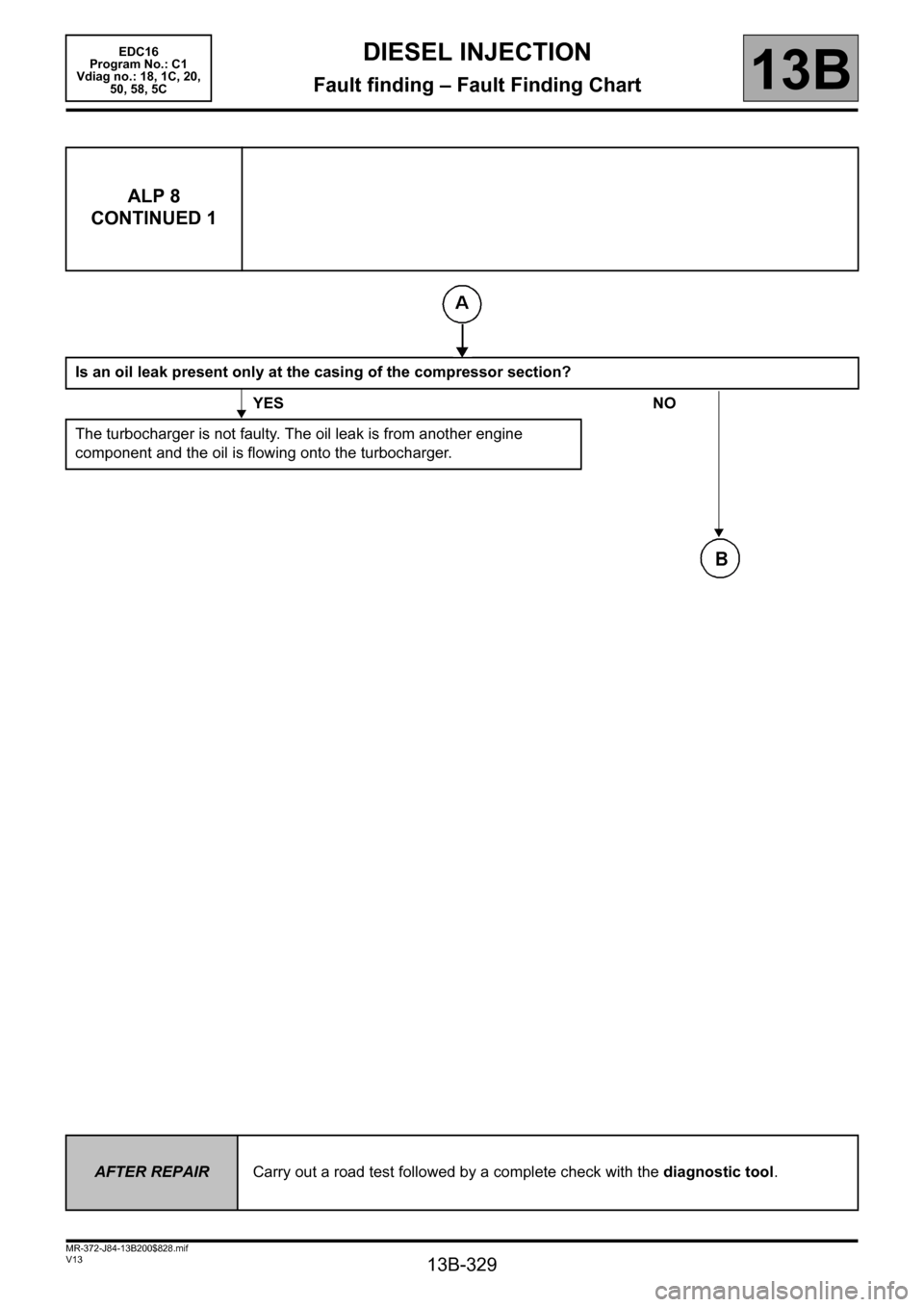
13B-329
MR-372-J84-13B200$828.mif
V13
EDC16
Program No.: C1
Vdiag no.: 18, 1C, 20,
50, 58, 5CDIESEL INJECTION
Fault finding – Fault Finding Chart13B
ALP 8
CONTINUED 1
Is an oil leak present only at the casing of the compressor section?
YES NO
The turbocharger is not faulty. The oil leak is from another engine
component and the oil is flowing onto the turbocharger.
AFTER REPAIRCarry out a road test followed by a complete check with the diagnostic tool.
Page 330 of 365
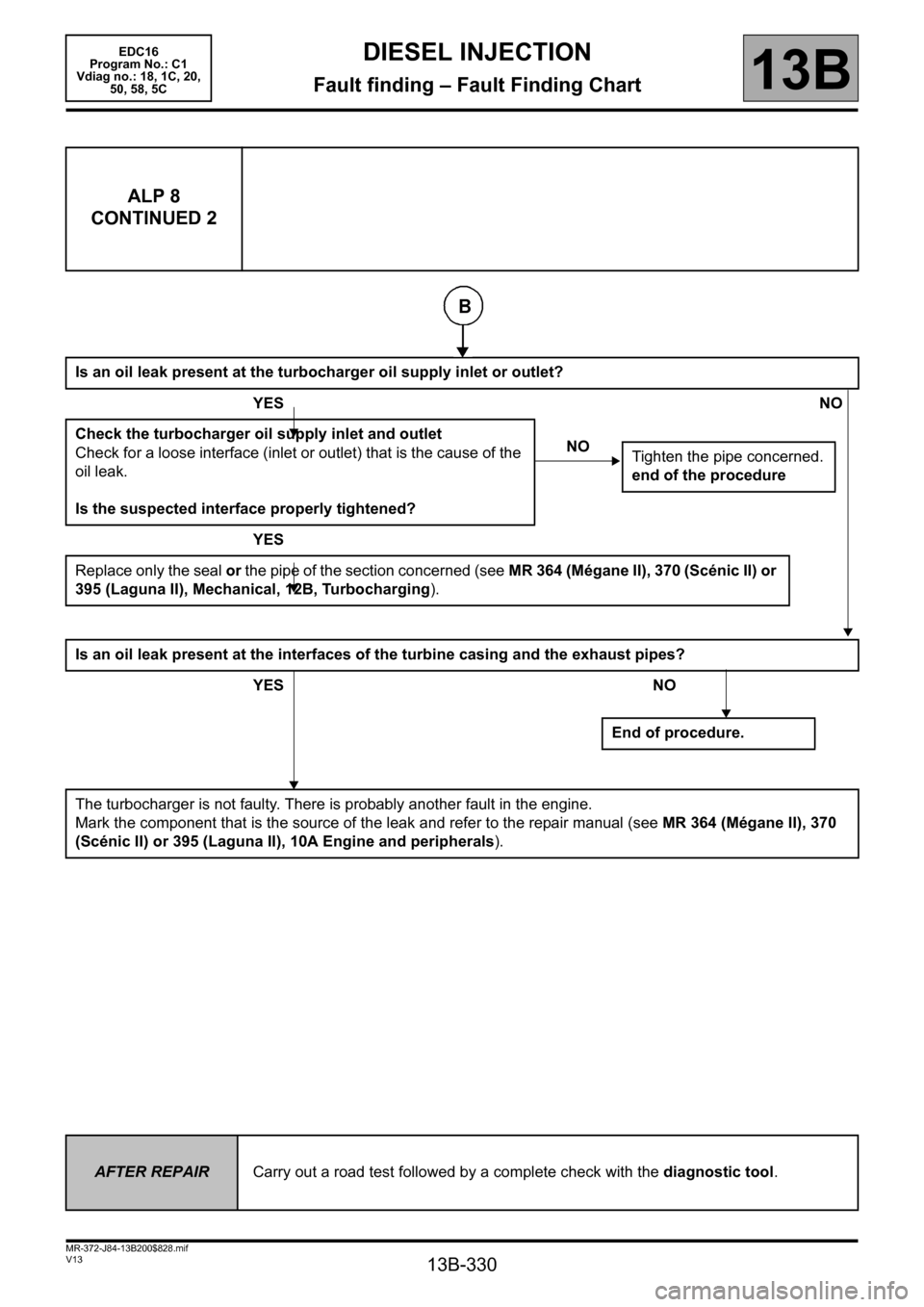
13B-330
MR-372-J84-13B200$828.mif
V13
EDC16
Program No.: C1
Vdiag no.: 18, 1C, 20,
50, 58, 5CDIESEL INJECTION
Fault finding – Fault Finding Chart13B
ALP 8
CONTINUED 2
Is an oil leak present at the turbocharger oil supply inlet or outlet?
YESNO
Check the turbocharger oil supply inlet and outlet
Check for a loose interface (inlet or outlet) that is the cause of the
oil leak.
Is the suspected interface properly tightened?
YES
Replace only the seal or the pipe of the section concerned (see MR 364 (Mégane II), 370 (Scénic II) or
395 (Laguna II), Mechanical, 12B, Turbocharging).
Is an oil leak present at the interfaces of the turbine casing and the exhaust pipes?
YES NO
The turbocharger is not faulty. There is probably another fault in the engine.
Mark the component that is the source of the leak and refer to the repair manual (see MR 364 (Mégane II), 370
(Scénic II) or 395 (Laguna II), 10A Engine and peripherals).
NO
Tighten the pipe concerned.
end of the procedure
End of procedure.
AFTER REPAIRCarry out a road test followed by a complete check with the diagnostic tool.
Page 331 of 365
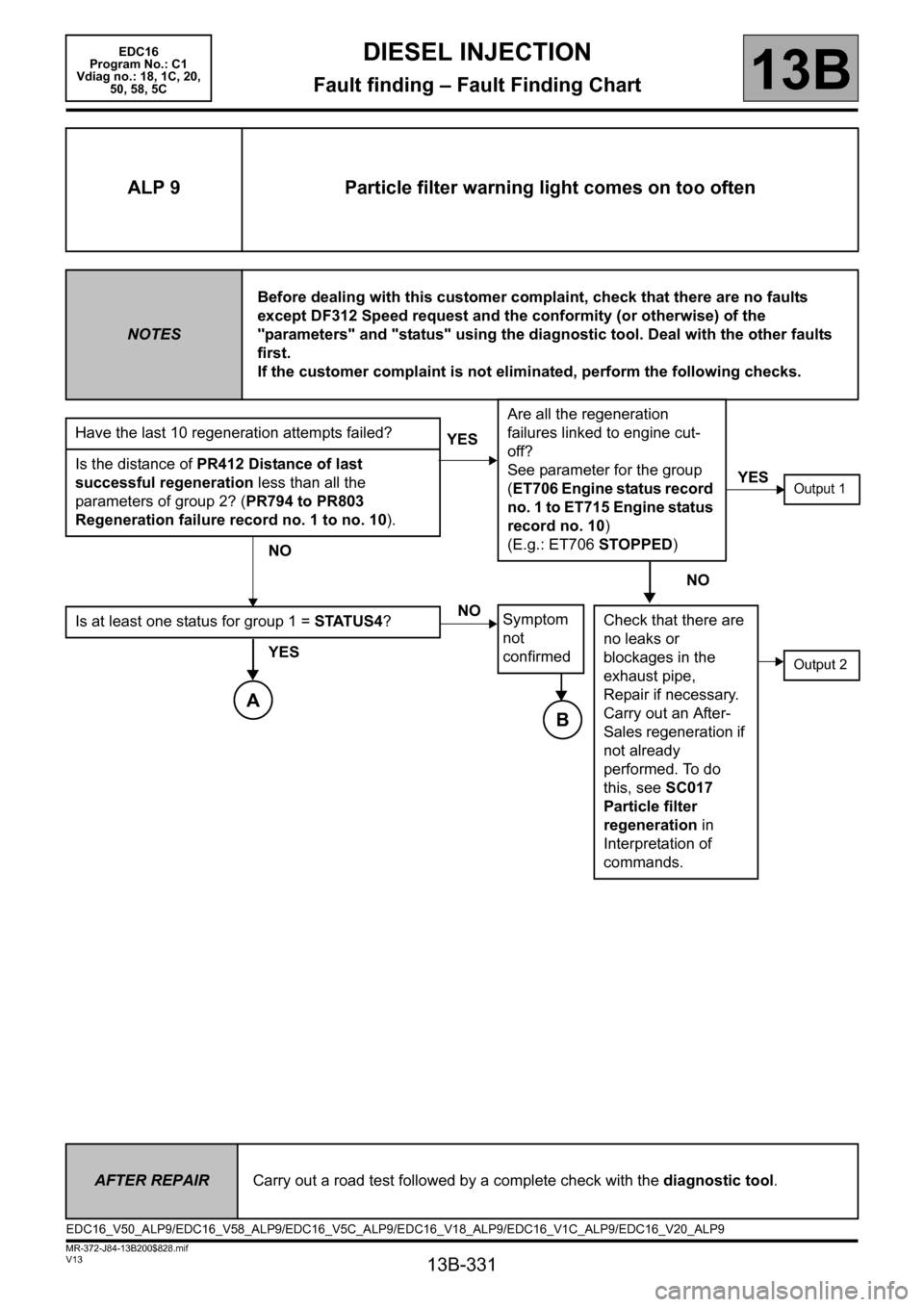
13B-331
MR-372-J84-13B200$828.mif
V13
EDC16
Program No.: C1
Vdiag no.: 18, 1C, 20,
50, 58, 5CDIESEL INJECTION
Fault finding – Fault Finding Chart13B
ALP 9 Particle filter warning light comes on too often
NOTESBefore dealing with this customer complaint, check that there are no faults
except DF312 Speed request and the conformity (or otherwise) of the
"parameters" and "status" using the diagnostic tool. Deal with the other faults
first.
If the customer complaint is not eliminated, perform the following checks.
Have the last 10 regeneration attempts failed?
Is the distance of PR412 Distance of last
successful regeneration less than all the
parameters of group 2? (PR794 to PR803
Regeneration failure record no. 1 to no. 10).
NO
Is at least one status for group 1 = STATUS4?
YES
YESAre all the regeneration
failures linked to engine cut-
off?
See parameter for the group
(ET706 Engine status record
no. 1 to ET715 Engine status
record no. 10)
(E.g.: ET706 STOPPED)
NO
Symptom
not
confirmed
YESOutput 1
NO
Check that there are
no leaks or
blockages in the
exhaust pipe,
Repair if necessary.
Carry out an After-
Sales regeneration if
not already
performed. To do
this, see SC017
Particle filter
regeneration in
Interpretation of
commands.
Output 2
AFTER REPAIRCarry out a road test followed by a complete check with the diagnostic tool.
EDC16_V50_ALP9/EDC16_V58_ALP9/EDC16_V5C_ALP9/EDC16_V18_ALP9/EDC16_V1C_ALP9/EDC16_V20_ALP9
A
B
Page 335 of 365
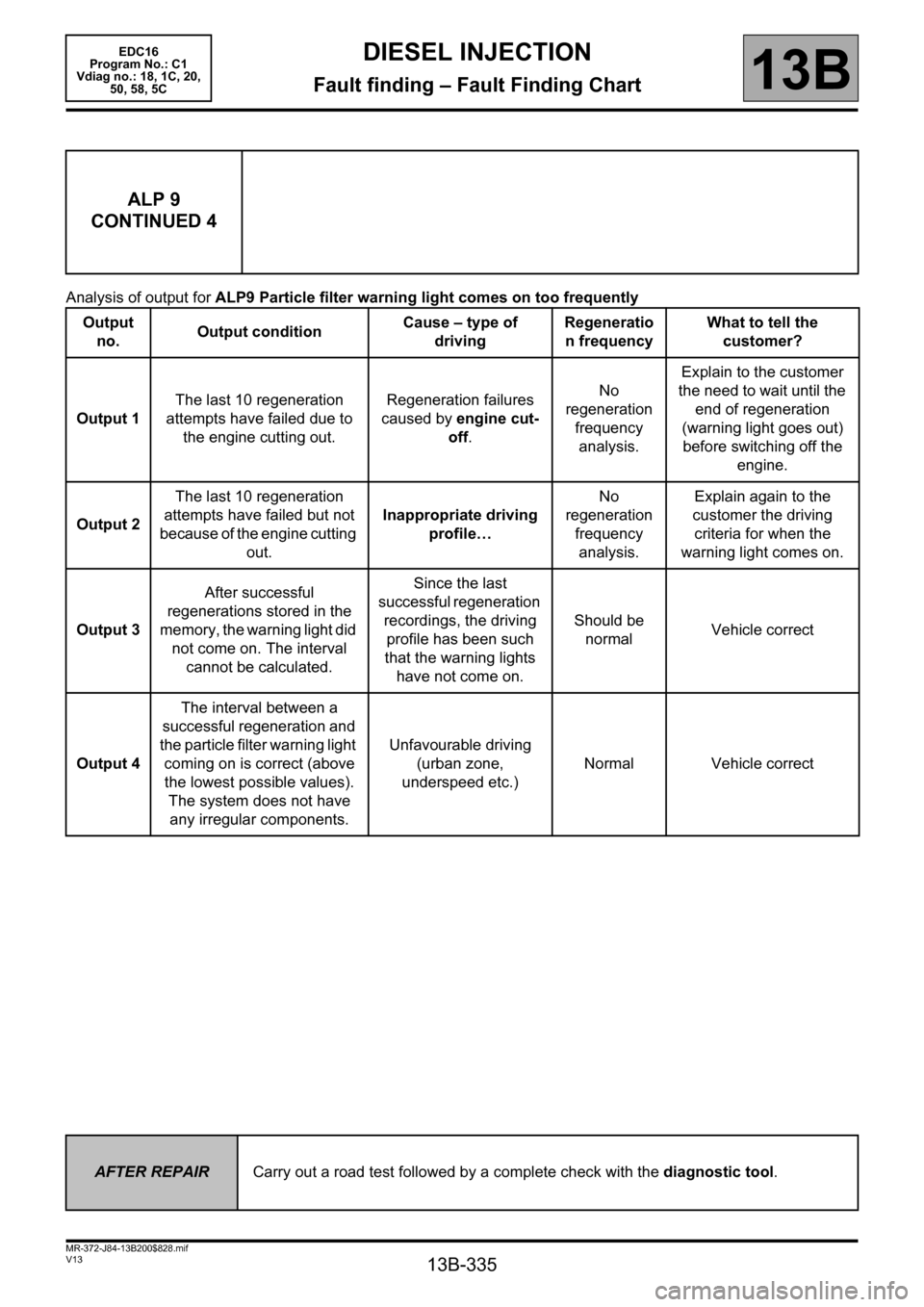
13B-335
MR-372-J84-13B200$828.mif
V13
DIESEL INJECTION
Fault finding – Fault Finding Chart
EDC16
Program No.: C1
Vdiag no.: 18, 1C, 20,
50, 58, 5C
13B
Analysis of output for ALP9 Particle filter warning light comes on too frequently
ALP 9
CONTINUED 4
Output
no. Output conditionCause – type of
drivingRegeneratio
n frequencyWhat to tell the
customer?
Output 1The last 10 regeneration
attempts have failed due to
the engine cutting out.Regeneration failures
caused by engine cut-
off.No
regeneration
frequency
analysis.Explain to the customer
the need to wait until the
end of regeneration
(warning light goes out)
before switching off the
engine.
Output 2The last 10 regeneration
attempts have failed but not
because of the engine cutting
out.Inappropriate driving
profile…No
regeneration
frequency
analysis.Explain again to the
customer the driving
criteria for when the
warning light comes on.
Output 3After successful
regenerations stored in the
memory, the warning light did
not come on. The interval
cannot be calculated.Since the last
successful regeneration
recordings, the driving
profile has been such
that the warning lights
have not come on.Should be
normalVehicle correct
Output 4The interval between a
successful regeneration and
the particle filter warning light
coming on is correct (above
the lowest possible values).
The system does not have
any irregular components.Unfavourable driving
(urban zone,
underspeed etc.)Normal Vehicle correct
AFTER REPAIRCarry out a road test followed by a complete check with the diagnostic tool.
Page 337 of 365
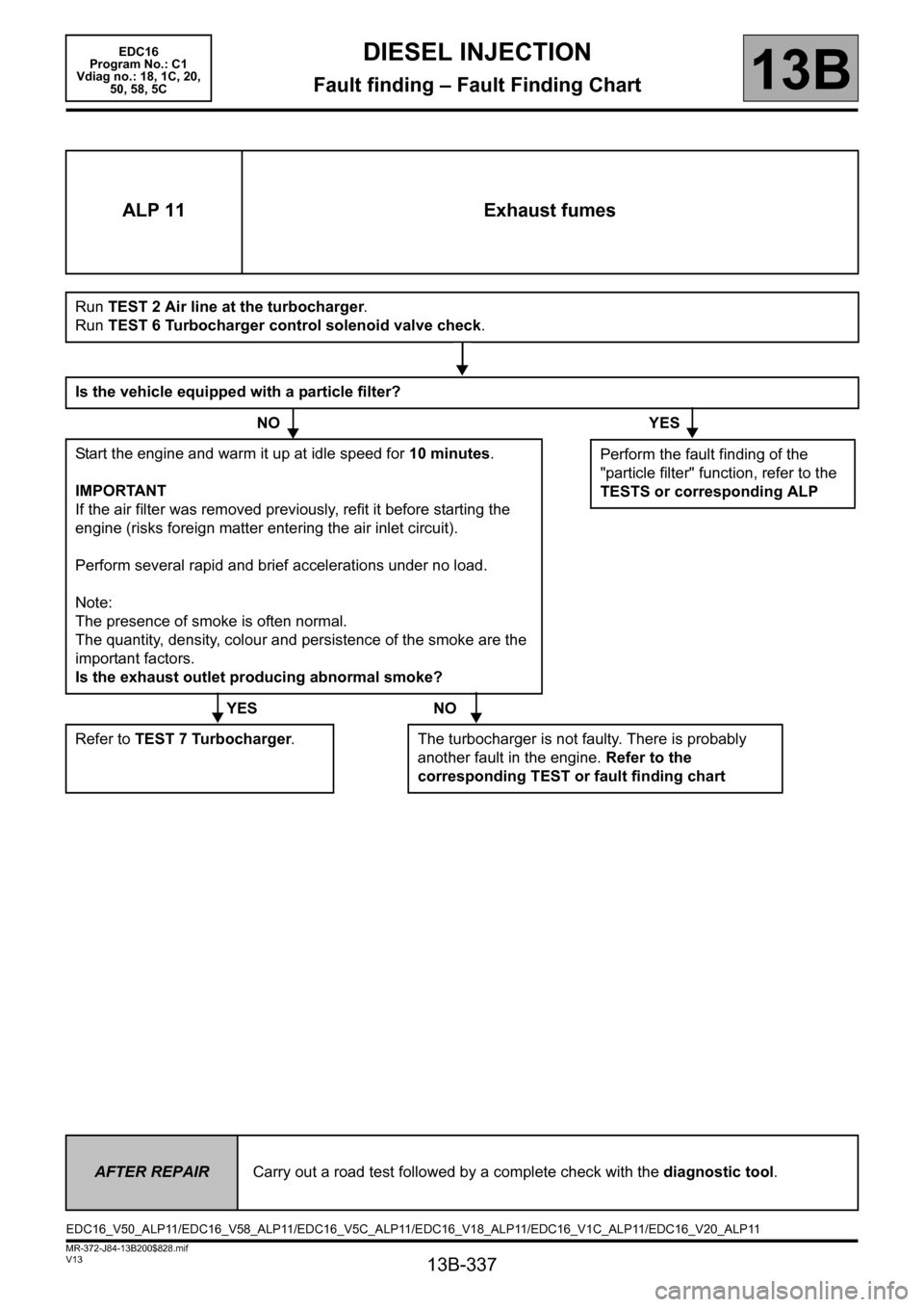
13B-337
MR-372-J84-13B200$828.mif
V13
EDC16
Program No.: C1
Vdiag no.: 18, 1C, 20,
50, 58, 5CDIESEL INJECTION
Fault finding – Fault Finding Chart13B
ALP 11 Exhaust fumes
Run TEST 2 Air line at the turbocharger.
Run TEST 6 Turbocharger control solenoid valve check.
Is the vehicle equipped with a particle filter?
NO YES
Start the engine and warm it up at idle speed for 10 minutes.
IMPORTANT
If the air filter was removed previously, refit it before starting the
engine (risks foreign matter entering the air inlet circuit).
Perform several rapid and brief accelerations under no load.
Note:
The presence of smoke is often normal.
The quantity, density, colour and persistence of the smoke are the
important factors.
Is the exhaust outlet producing abnormal smoke?
YES NO
Refer to TEST 7 Turbocharger. The turbocharger is not faulty. There is probably
another fault in the engine. Refer to the
corresponding TEST or fault finding chart
Perform the fault finding of the
"particle filter" function, refer to the
TESTS or corresponding ALP
AFTER REPAIRCarry out a road test followed by a complete check with the diagnostic tool.
EDC16_V50_ALP11/EDC16_V58_ALP11/EDC16_V5C_ALP11/EDC16_V18_ALP11/EDC16_V1C_ALP11/EDC16_V20_ALP11
Page 338 of 365
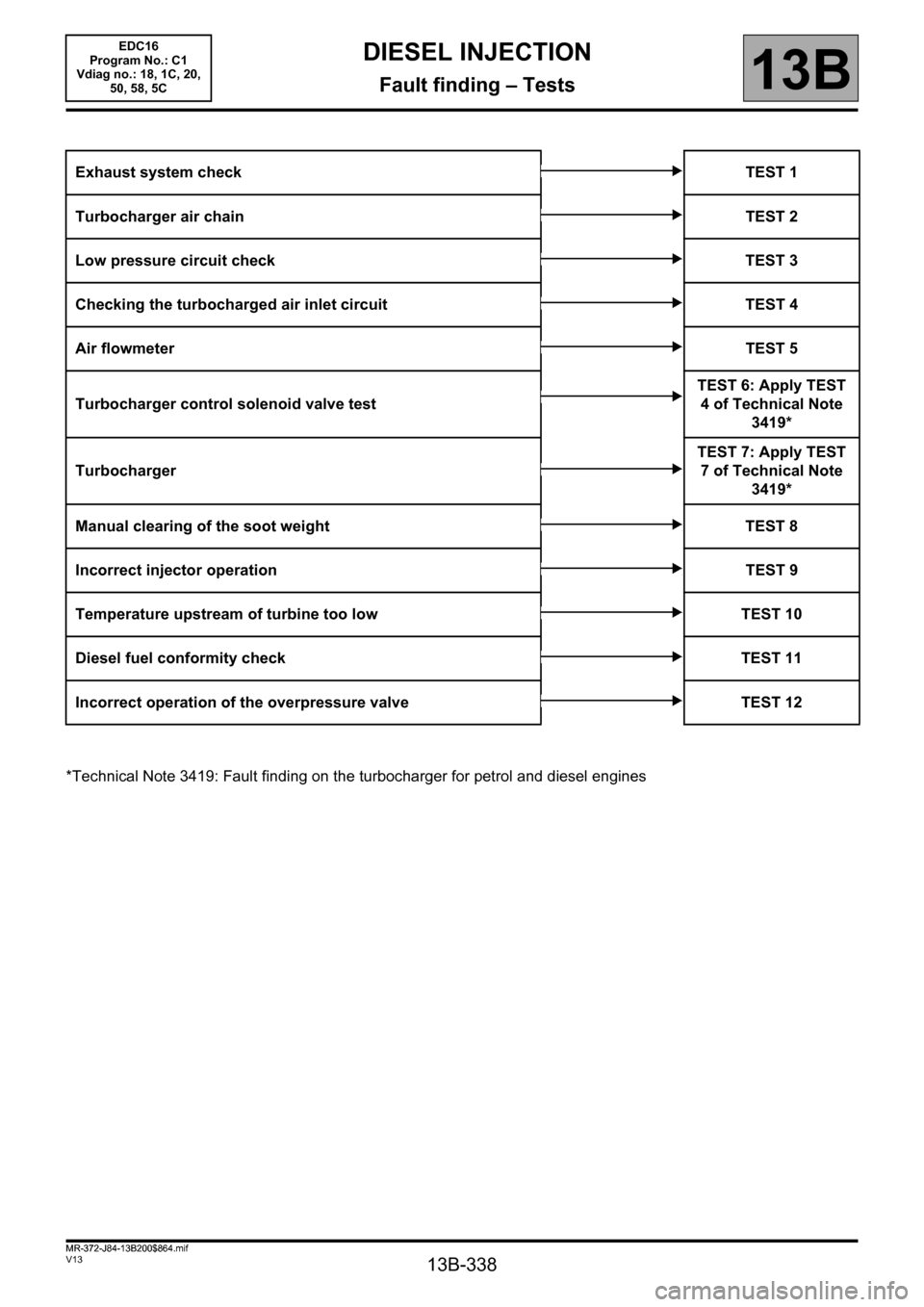
13B-338
MR-372-J84-13B200$864.mif
V13
13B
DIESEL INJECTION
Fault finding – Tests
*Technical Note 3419: Fault finding on the turbocharger for petrol and diesel engines Exhaust system checkTEST 1
Turbocharger air chainTEST 2
Low pressure circuit check TEST 3
Checking the turbocharged air inlet circuit TEST 4
Air flowmeterTEST 5
Turbocharger control solenoid valve testTEST 6: Apply TEST
4 of Technical Note
3419*
TurbochargerTEST 7: Apply TEST
7 of Technical Note
3419*
Manual clearing of the soot weight TEST 8
Incorrect injector operation TEST 9
Temperature upstream of turbine too low TEST 10
Diesel fuel conformity check TEST 11
Incorrect operation of the overpressure valve TEST 12
EDC16
Program No.: C1
Vdiag no.: 18, 1C, 20,
50, 58, 5C
MR-372-J84-13B200$864.mif
Page 339 of 365
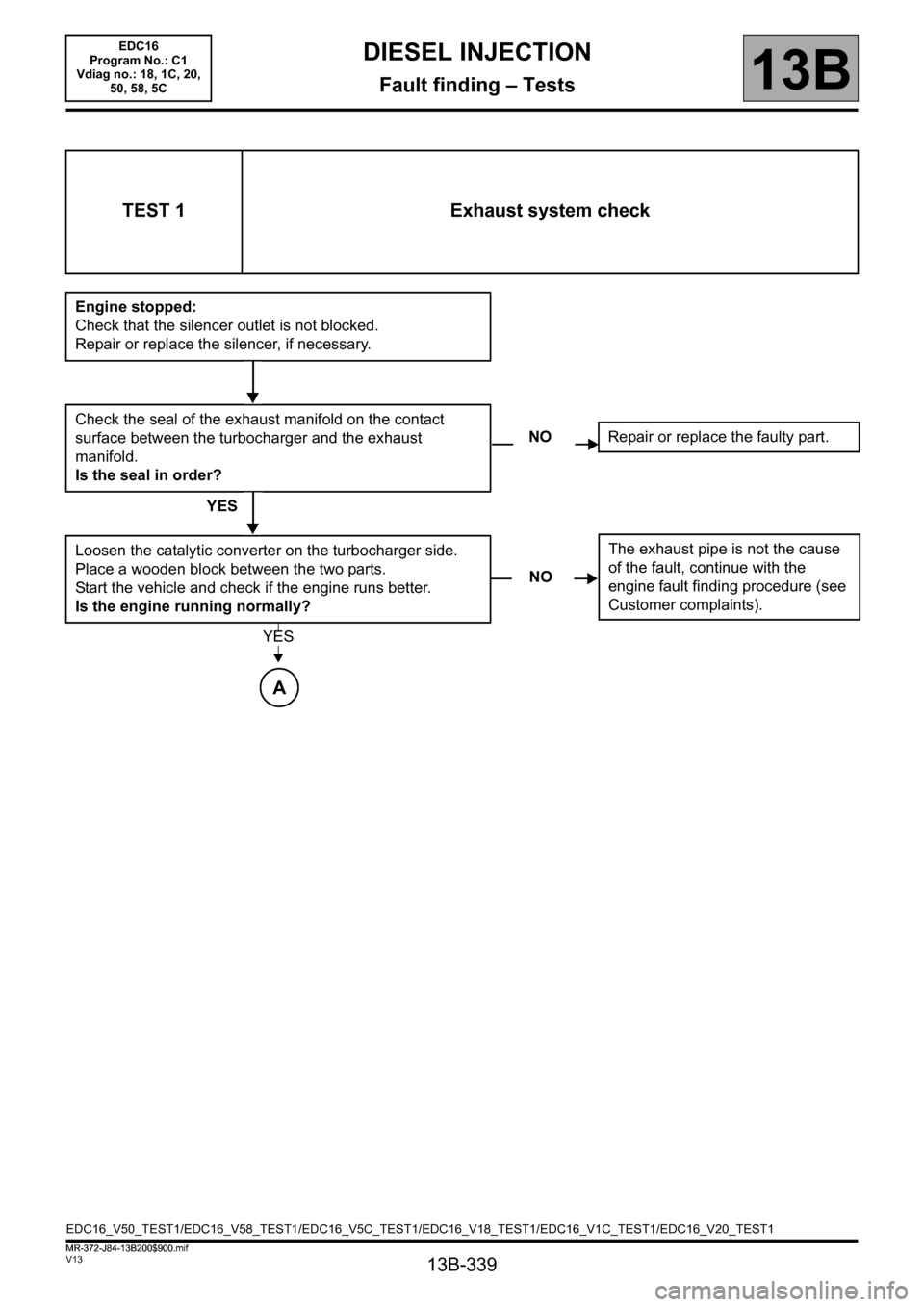
13B-339
MR-372-J84-13B200$900.mif
V13
13B
DIESEL INJECTION
Fault finding – Tests
TEST 1 Exhaust system check
Engine stopped:
Check that the silencer outlet is not blocked.
Repair or replace the silencer, if necessary.
Check the seal of the exhaust manifold on the contact
surface between the turbocharger and the exhaust
manifold.
Is the seal in order?
YES
Loosen the catalytic converter on the turbocharger side.
Place a wooden block between the two parts.
Start the vehicle and check if the engine runs better.
Is the engine running normally?
YES
A
NORepair or replace the faulty part.
NOThe exhaust pipe is not the cause
of the fault, continue with the
engine fault finding procedure (see
Customer complaints).
EDC16_V50_TEST1/EDC16_V58_TEST1/EDC16_V5C_TEST1/EDC16_V18_TEST1/EDC16_V1C_TEST1/EDC16_V20_TEST1 EDC16
Program No.: C1
Vdiag no.: 18, 1C, 20,
50, 58, 5C
MR-372-J84-13B200$900.mif